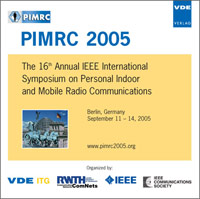IEEE 802.16e System Performance: Analysis and Simulations
Konferenz: PIMRC 2005 - 16th Annual IEEE International Symposium on Personal Indoor and Mobile Radio Communications
11.09.2005 - 14.09.2005 in Berlin, Germany
Tagungsband: PIMRC 2005
Seiten: 5Sprache: EnglischTyp: PDF
Persönliche VDE-Mitglieder erhalten auf diesen Artikel 10% Rabatt
Autoren:
Wang, Fan; Ghosh, Amitava; Ratasuk, Rapeepat (Advanced Radio Technology, GTSS, Motorola Inc. 1441 W. Shure Drive, Arlington Heights, IL 60004, USA)
Love, Robert; Stewart, Kenneth; Bachu, Raja (Applied Research & Technology, PCS, Motorola Inc. 600 North U.S. Hwy 45, Libertyville, IL 60048, USA)
Sun, Yakun; Zhao, Qing (School of Electrical and Computer Engineering, Georgia Institute of Technology, Atlanta, GA 30332, USA)
Inhalt:
In this paper, the performance of a prototypical IEEE 802.16e network is analyzed via link and system simulations. The Exponential Effective SIR Mapping (EESM) is used to map the instantaneous SINR of received signals to a service-specific packet erasure rate (PER), which is in turn used to assess the downlink and uplink network and user data throughput. A variety of data traffic models are considered, including web browsing (HTTP) and full buffer sessions, operating in flat-fading and frequency-selective multipath channels such as the ITU Pedestrian-B model. The downlink network performance of the prototypical IEEE 802.16e network is compared to a 3GPP UMTS High Speed Downlink Packet Access (HSDPA) system of similar physical dimensions. System simulation results for the prototypical IEEE 802.16e network considered show - when frequency-selective scheduling is not applied - that the IEEE 802.16e downlink has similar throughput performance as HSDPA for a 70/30 TDD DL/UL frame split but approximately 40% - 50% higher spectral efficiency, although control channel overhead and uplink capacity limitation remain significant open issues for further study.


